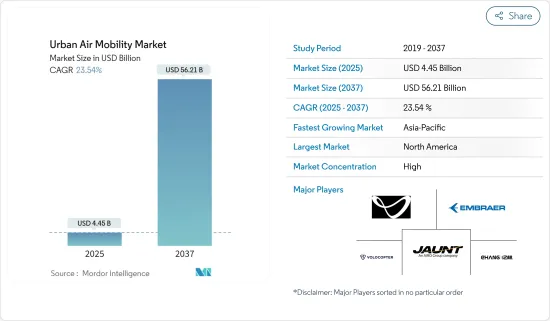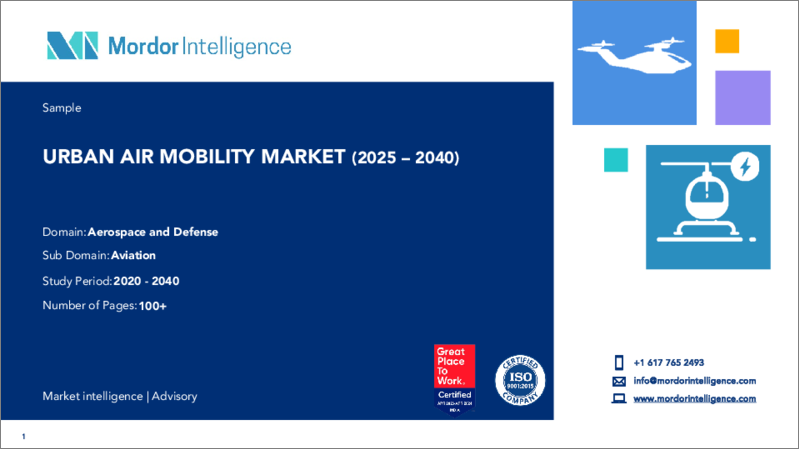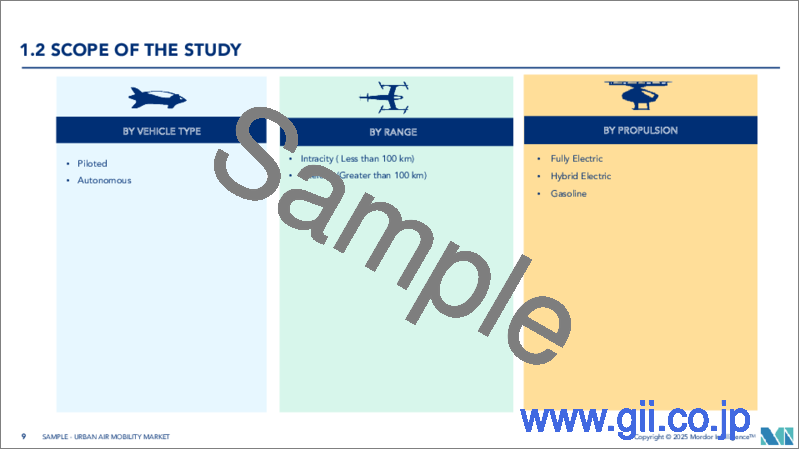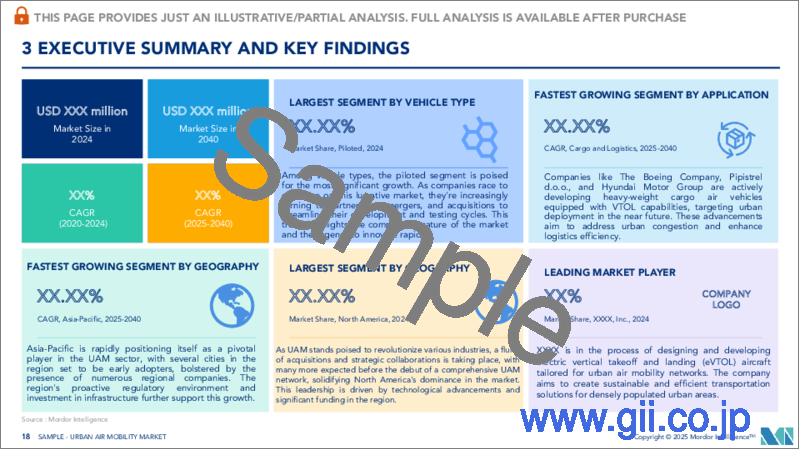|
|
市場調査レポート
商品コード
1687978
アーバンエアモビリティ:市場シェア分析、産業動向・統計、成長予測(2025年~2037年)Urban Air Mobility - Market Share Analysis, Industry Trends & Statistics, Growth Forecasts (2025 - 2037) |
||||||
カスタマイズ可能
適宜更新あり
|
|||||||
| アーバンエアモビリティ:市場シェア分析、産業動向・統計、成長予測(2025年~2037年) |
|
出版日: 2025年03月18日
発行: Mordor Intelligence
ページ情報: 英文 119 Pages
納期: 2~3営業日
|
- 全表示
- 概要
- 目次
アーバンエアモビリティの市場規模は2025年に44億5,000万米ドルと推定され、2037年には562億1,000万米ドルに達すると予測され、予測期間(2025-2037年)のCAGRは23.54%です。

COVID-19パンデミックは、世界のあらゆる産業にかつてない影響を及ぼしています。航空部門はパンデミックの深刻な影響を受けています。アーバンエアモビリティー(UAM)セクターの主要企業のほとんどが航空セクターに直接的または間接的に関係しているため、パンデミックはUAMセクターに波及効果をもたらしました。COVID-19が発生する前は、まだ形成段階にあったUAM部門は、健全な開発ペースと高い投資額で健全な成長を目の当たりにしていました。しかし、COVID-19の流行は遅延を引き起こし、2020年の短期に予定されていたプロジェクトの立ち上げに影響を与えました。とはいえ、この遅れは短期的なものであり、UAMの一般的な展開を危うくするものではありません。
特に大都市では交通渋滞の問題が深刻化しており、より高速な都市内交通手段の必要性が高まっています。この点で、アーバン・エアモビリティのコンセプトは重要性を増しています。アーバンエアモビリティー産業には多くの研究開発投資が行われており、多くの新興企業や航空宇宙プレーヤーがこの市場を高い成長の可能性を秘めた市場として注目しています。したがって、こうした要因が予測期間中の市場成長の焦点を押し上げると予想されます。
アーバンエアモビリティ(UAM)市場の動向
予測期間中、自律型セグメントが最も高い成長を予測
自律型セグメントは予測期間中に著しい成長を示すと予測されます。自律型eVTOLは、垂直離着陸が可能で、操縦にパイロットを必要としない電動航空機です。これらの航空機は、都市部で乗客や貨物を輸送するために設計されており、通常は電気モーターを動力源としています。これらの航空機は、電気モーター、バッテリー、フライ・バイ・ワイヤ・システムなど、さまざまな先進技術を駆使して安全かつ効率的に運航しています。また、先進的なセンサーや制御システムを使って都市環境を航行し、障害物を回避します。
業界の専門家の中には、完全自律飛行は急進的な道だと考える者もいるが、民間機や軍用機ですでに利用されている現在の自律性レベルを見ることで、その決断を合理化した企業はほとんどないです。Wisk Aero社やEHang社は、現在自律型eVTOLを開発している企業の一部です。2022年10月、ボーイング社とキティホークの合弁会社であるウィスク・エアロは、第6世代の4人乗り自律型eVTOL機を発表しました。同社は米国での旅客試験を開始するため、FAAの認定取得を目指しています。ウィスク・エアロの新しい第6世代eVTOlは、水平または垂直に傾けることができる5枚のブレードからなる6つのフロントローターと、垂直位置で固定された2枚のブレードからなる6つのリアローターを備えています。この航空機は、高度2,500~4,000フィートで120ノットの巡航速度に達し、航続距離は140kmに達するとしています。例えば、ウィスク・エアロは、2027年までに自律型エアタクシー・サービスを開始することを構想しており、世界の約20の主要市場で年間1,400万便を運航すると予測しています。
自律型eVTOLには、従来の航空機や地上交通手段にはない利点がいくつかあります。eVTOLは、滑走路やその他の特殊なインフラを必要とせず、都市部でも運行できるため、混雑や公害を軽減できます。また、地上ベースの輸送手段よりも高速で効率的である可能性があり、ルーティングやスケジューリングの面でより高い柔軟性を提供できます。
アジア太平洋地域が予測期間中に最も高い成長を遂げる見込み
アジア太平洋地域は、UAMセクターにとって重要な勢いの源として急浮上しています。同地域のいくつかの都市は、同分野に複数の地域企業が進出していることから、UAM技術の早期導入が期待されています。中国、日本、韓国のような様々な国々が、政府とともにこの地域のUAMエコシステムの開発に今後数年間、積極的に投資しています。例えば、日本の国土交通省は2021年6月、航空モビリティをめぐる規制や問題を扱う次世代航空モビリティ企画室の設置を発表しました。日本政府は、2023年までに旅客用ドローン、空飛ぶクルマ、その他の先進的航空車両(AAV)の運用を導入することを目指しています。政府はまた、2025年の大阪・関西日本万国博覧会に向けて、より大規模な航空モビリティの運用を展開する予定です。UAM輸送を導入する政府のこうした計画は、この技術に投資する企業を後押ししています。
さらに、2022年5月、第7回India Ideas Conclaveの一環として開催されたIndia@2047において、民間航空省は、米国とカナダでの試験が終了した後、全国で電動垂直離着陸(eVTOL)の形で都市型航空モビリティを導入すると発表しました。このような開発は、予測期間中にこの地域のUAM市場の成長を加速させると予想されます。
アーバンエアモビリティ(UAM)産業の概要
都市型エアモビリティー市場は統合されており、市場で大きなシェアを占める企業はごく少数です。Embraer SA(Eve UAM LLCを通じて)、Volocopter GmbH、Guangzhou EHang Intelligent Technology、Joby Aero, Inc.、Jaunt Air Mobility CorporationなどがUAM市場の有力企業です。市場はまだ開発段階にあり、多くのプレーヤーが提携やパートナーシップを通じて、今後数年のうちに最初のUAMユニットを顧客に提供し、航空機運航会社と共同で飛行試験段階を開始しようとしています。この点に関して、Eve UAM LLCは、2022年2月にブラジル民間航空局(ANC)にeVTOL機の型式証明を正式に取得する手続きを行ったと発表しました。現在、イヴは最大700機のeVTOL機の発注を受けています。両社は規制当局からの承認取得に向けて動き出しており、今後数年のうちに飛行試験が開始される見込みで、航空機運航会社/航空モビリティ・サービス・プロバイダーからの受注によって地理的プレゼンスを高めることができます。
その他の特典:
- エクセル形式の市場予測(ME)シート
- 3ヶ月間のアナリスト・サポート
目次
第1章 イントロダクション
- 調査の前提条件
- 調査範囲
第2章 調査手法
第3章 エグゼクティブサマリー
第4章 市場力学
- 市場概要
- 市場促進要因
- 市場抑制要因
- ポーターのファイブフォース分析
- 買い手/消費者の交渉力
- 供給企業の交渉力
- 新規参入業者の脅威
- 代替品の脅威
- 競争企業間の敵対関係の強さ
第5章 市場セグメンテーション
- 車両タイプ
- パイロット型
- 自律型
- 用途
- 旅客輸送
- 貨物船
- 地域
- 北米
- 欧州
- アジア太平洋
- ラテンアメリカ
- 中東・アフリカ
第6章 競合情勢
- 企業プロファイル
- Airbus SE
- Volocopter GmbH
- Embraer SA
- Honeywell International Inc.
- Hyundai Motor Group
- Jaunt Air Mobility Corporation
- Karem Aircraft Inc.
- Opener Inc.
- PIPISTREL d.o.o.
- Safran SA
- Textron Inc.
- The Boeing Company
- Joby Aero Inc.
- Guangzhou EHang Intelligent Technology Co. Ltd
第7章 市場機会と今後の動向
The Urban Air Mobility Market size is estimated at USD 4.45 billion in 2025, and is expected to reach USD 56.21 billion by 2037, at a CAGR of 23.54% during the forecast period (2025-2037).

The COVID-19 pandemic has had an unprecedented impact on all industries globally. The aviation sector has been severely affected by the pandemic. Since most of the major urban air mobility (UAM) sector players are directly or indirectly related to the aviation sector, the pandemic has had a ripple effect on the UAM sector. Before the COVID-19 outbreak, the UAM sector, which was still in its formative stages, witnessed healthy growth with a healthy pace of development and high investments. However, the COVID-19 pandemic caused delays and affected project launches scheduled in the short term in 2020. Nevertheless, the delays were witnessed only for the short term and did not jeopardize the general deployment of UAM.
The growing traffic congestion issues, especially in larger cities, are propelling the need for faster modes of intracity transportation. In this regard, the urban air mobility concept is gaining importance. There are many R&D investments in the urban air mobility industry, with many start-ups and aerospace players eyeing this market as one with high growth potential. Therefore, such factors are expected to drive the market's growth focus during the forecast period.
Urban Air Mobility (UAM) Market Trends
Autonomous Segment is Projected to Highest Growth During the Forecast Period
An autonomous segment is estimated to show remarkable growth during the forecast period. An autonomous eVTOL is an electric aircraft that can take off and land vertically and does not require a pilot on board to operate. These aircraft are designed to transport passengers and cargo in urban areas and are typically powered by electric motors. These aircraft use a range of advanced technologies, including electric motors, batteries, and fly-by-wire systems, to operate safely and efficiently. They also use advanced sensors and control systems to navigate through the urban environment and avoid obstacles.
Some industry experts believe fully autonomous flight is a radical path, while few companies have rationalized their decision by looking at the current levels of autonomy already being utilized by commercial and military aircraft. Wisk Aero and EHang are some of the players currently developing autonomous eVTOLs. On this note, in October 2022, Wisk Aero, which is a joint venture between The Boeing Company and Kitty Hawk, unveiled its sixth-generation four-seater autonomous eVTOL aircraft. The company hopes to receive FAA certification to initiate passenger testing in the US. The new sixth-generation eVTOl from Wisk Aero features six front rotors, each with five blades that can tilt either horizontally or vertically, as well as six rear rotors that each consist of two blades and remain fixed in a vertical position. The aircraft claims to reach a cruising speed of 120 knots at an altitude of 2,500 to 4,000 ft and a range of 140 km. For instance, Wisk Aero envisions launching autonomous air taxi services by 2027 and predicts conducting 14 million flights annually in around 20 major markets around the globe.
Autonomous eVTOLs have several advantages over traditional aircraft and ground-based transportation modes. They can operate in urban areas without the need for runways or other specialized infrastructure, which can reduce congestion and pollution. They also have the potential to be faster and more efficient than ground-based transportation modes and can provide greater flexibility in terms of routing and scheduling.
Asia-Pacific Region Expected to Witness Highest Growth During the Forecast Period
The Asia-Pacific region is fast emerging as a key source of momentum for the UAM sector. Several cities in the region are expected to be early adopters of UAM technology due to the prevalence of several regional companies in the sector. Various countries like China, Japan, and South Korea have been robustly investing in the development of UAM ecosystems in the region in the coming years with the governments. For instance, in June 2021, the Ministry of Land, Infrastructure, Transport, and Tourism in Japan announced the formation of the Next Generation Aviation Mobility Planning Office, which will handle regulations and issues surrounding aviation mobility. The government of Japan aims to introduce the operations of passenger drones, flying cars, and other advanced aviation vehicles (AAV) by 2023. The government also plans to roll out larger-scale air mobility operations for Osaka-Kansai Japan World Expo in 2025. Such plans of the governments to introduce UAM transportation are supporting the companies investing in the technology.
Furthermore, in May 2022, during the India@2047, as part of the seventh edition of India Ideas Conclave, the Civil Aviation Ministry announced that the country would have urban air mobility in the form of Electric Vertical Take Off and Landing (eVTOL) across the country, after the trials in the United States and Canada are over. Such developments are anticipated to accelerate the growth UAM market in the region during the forecast period.
Urban Air Mobility (UAM) Industry Overview
The urban air mobility market is consolidated, with very few companies accounting for a significant market share in the market. Embraer SA (through Eve UAM LLC), Volocopter GmbH, Guangzhou EHang Intelligent Technology Co. Ltd, Joby Aero, Inc., and Jaunt Air Mobility Corporation are some prominent players in the UAM market. The market is still in its development phase, with many players, through collaborations and partnerships, trying to deliver the first UAM units to their customers in the coming years and begin flight testing stages in collaboration with aircraft operators. In this regard, Eve UAM LLC announced that the company formalized the process of obtaining a Type Certificate for its eVTOL aircraft with the Civil Aviation Agency of Brazil (ANC) in February 2022. Currently, Eve has an order for up to 700 eVTOL aircraft. As the companies are moving toward receiving approvals from the regulatory authorities, flight testing is expected to begin in the coming years, allowing them to enhance their geographical presence by receiving orders from aircraft operators/aerial mobility service providers in the coming years.
Additional Benefits:
- The market estimate (ME) sheet in Excel format
- 3 months of analyst support
TABLE OF CONTENTS
1 INTRODUCTION
- 1.1 Study Assumptions
- 1.2 Scope of Study
2 RESEARCH METHODOLOGY
3 EXECUTIVE SUMMARY
4 MARKET DYNAMICS
- 4.1 Market Overview
- 4.2 Market Drivers
- 4.3 Market Restraints
- 4.4 Porter's Five Forces Analysis
- 4.4.1 Bargaining Power of Buyers/Consumers
- 4.4.2 Bargaining Power of Suppliers
- 4.4.3 Threat of New Entrants
- 4.4.4 Threat of Substitute Products
- 4.4.5 Intensity of Competitive Rivalry
5 MARKET SEGMENTATION
- 5.1 Vehicle Type
- 5.1.1 Piloted
- 5.1.2 Autonomous
- 5.2 Application
- 5.2.1 Passenger Transport
- 5.2.2 Freighter
- 5.3 Geography
- 5.3.1 North America
- 5.3.2 Europe
- 5.3.3 Asia-Pacific
- 5.3.4 Latin America
- 5.3.5 Middle-East and Africa
6 COMPETITIVE LANDSCAPE
- 6.1 Company Profiles
- 6.1.1 Airbus SE
- 6.1.2 Volocopter GmbH
- 6.1.3 Embraer SA
- 6.1.4 Honeywell International Inc.
- 6.1.5 Hyundai Motor Group
- 6.1.6 Jaunt Air Mobility Corporation
- 6.1.7 Karem Aircraft Inc.
- 6.1.8 Opener Inc.
- 6.1.9 PIPISTREL d.o.o.
- 6.1.10 Safran SA
- 6.1.11 Textron Inc.
- 6.1.12 The Boeing Company
- 6.1.13 Joby Aero Inc.
- 6.1.14 Guangzhou EHang Intelligent Technology Co. Ltd






